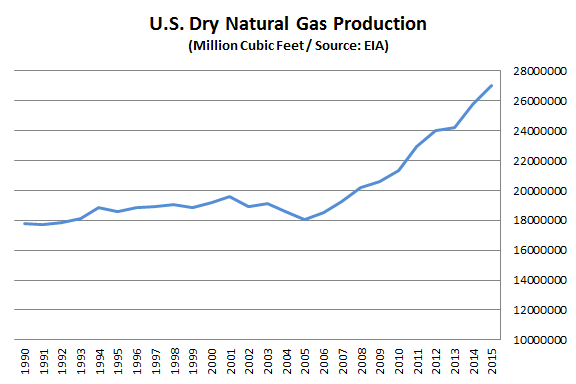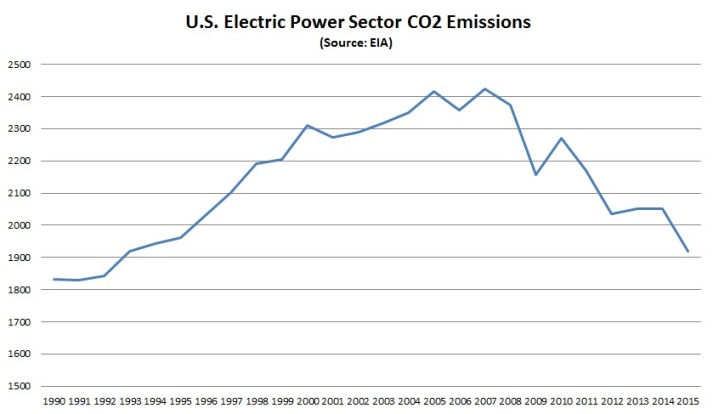The Climate Success of the U.S. Model
Mark Green
Posted August 31, 2016
In recent months we’ve posted a number of times on the “U.S. Model” of domestic energy and economic growth – coupled with greenhouse gas reductions (see here, here and here). Let that sink in: The United States is simultaneously the world’s No. 1 producer of oil and natural gas and the world leader in reducing emissions. Energy growth and climate progress together. That’s the U.S. Model.
It’s important to grasp the impacts of the U.S. model – and also how it came about. Because despite nearly a decade of energy, economic and climate progress, all stemming from America’s energy renaissance, some continue to push for new energy regulation that could put all of these benefits at risk. API President and CEO Jack Gerard during a press briefing:
“It was really through innovation – horizontal drilling and hydraulic fracturing – that we were able to produce vast amounts of cleaner-burning, reliable, affordable energy. And that’s what’s allowed us to see this significant shift in the energy equation. It wasn’t government regulation.”
Looking at the plus side of this equation, we see energy growth, lots of it. In domestic crude oil production:

And also natural gas output:

These surges in home-grown oil and gas production are making the United States stronger economically and more secure in the world, reducing our dependence on others for the fuels that run our economy and support our standard of living.
The absolute stunner is that, contrary to the established historic pattern, U.S. energy and economic growth hasn’t been accompanied by emissions increases. Instead, greenhouse gas emissions have declined. Go figure: While much of the industrialized world continues talking about how to reduce emissions, the United States is doing it. We see this in reduced carbon dioxide emissions from electricity generation, now at levels not seen in more than two decades:

Also in reduced methane emissions, with industry capturing more and more of the primary component in natural gas:

Gerard calls the above a “proven record of success.” Gerard:
“We have a proven record of success. It’s not a theoretical or philosophical conversation about what regulation’s good or bad. We’ve now demonstrated (that) market forces have driven us to leading the world in reducing carbon emissions. We think we’ve got to recognize that and what brought us there and focus on those opportunities, not to come out with some idea as to how we’re now going to change that behavior by imposing unnecessary and in many ways redundant regulations. … Methane emission reductions followed the industry lead in reducing methane. Methane was going down dramatically, even with the significant uptick in natural gas production, and the regulators came along after fact and began to regulate.”
The U.S. Model is a winning model, one that should be embraced if we’re serious about making climate progress without risking sacrificing jobs, our economy and our security. Years ago, a number of environmentalists supported increased use of natural gas as a key part of America’s energy present and future. Turns out, they were right. Surging production of cleaner-burning natural gas is at the heart of the U.S. energy renaissance and U.S. climate progress. The way forward is to produce more gas safely, in an environmentally responsible way, not to impede domestic production with unnecessary regulation. Gerard:
“We are leading the world in carbon reductions today, and it’s driven primarily by cleaner-burning, affordable, reliable natural gas that was brought to you by innovation and technological advancements in the oil and natural gas industry. … You don’t get to efficient, affordable, reliable natural gas by imposing over a hundred new regulations on an industry, which is what we’re dealing with right now from the administration. … These outcomes are not mutually exclusive. We can have increased oil and gas development while also further enhancing our environmental protection.”
About The Author
Mark Green joined API after a career in newspaper journalism, including 16 years as national editorial writer for The Oklahoman in the paper’s Washington bureau. Previously, Mark was a reporter, copy editor and sports editor at an assortment of newspapers. He earned his journalism degree from the University of Oklahoma and master’s in journalism and public affairs from American University. He and his wife Pamela have two grown children and six grandchildren.


